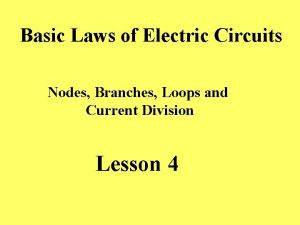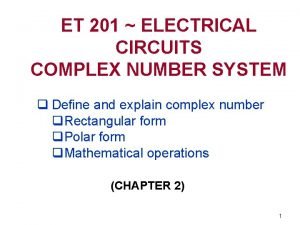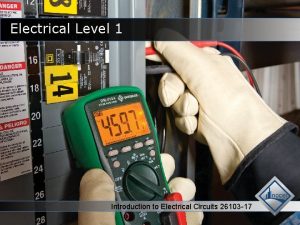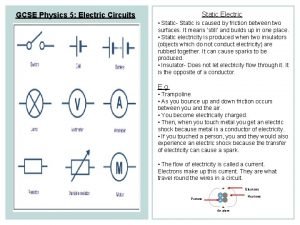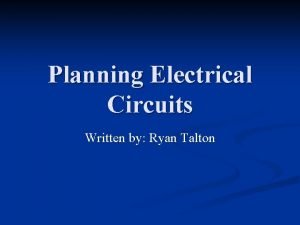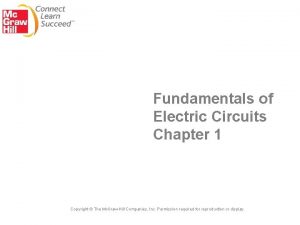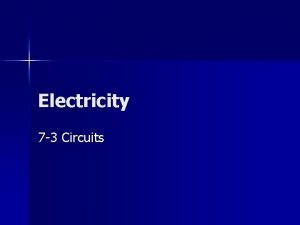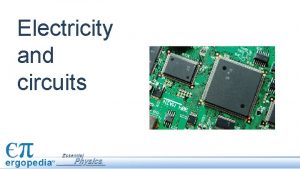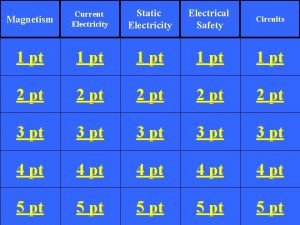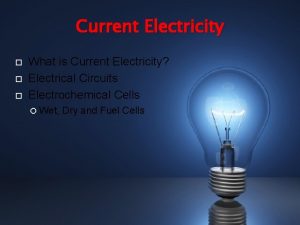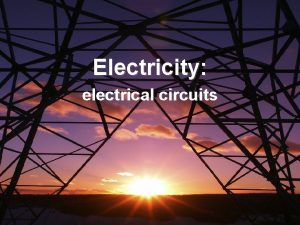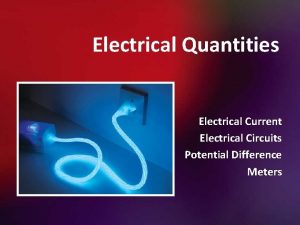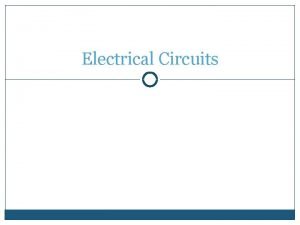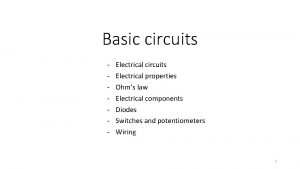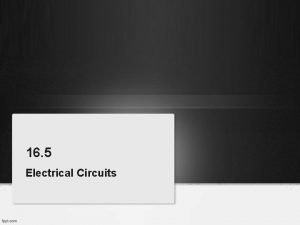ELECTRICAL CIRCUITS Electricity and Circuits Up to this















- Slides: 15

ELECTRICAL CIRCUITS

Electricity and Circuits Up to this point we have learned that static electricity can build up to a point where it results in the discharge of that energy in the form of a spark or lightning strike. Next we will draw on your prior knowledge (gr. 6) to help learn about currents and circuits.

• Electric Current – the movement or flow of electric charges from one place to another. Electric Circuit – a controlled path in which electric current passes through. Electric circuits are used to convert electrical energy into other forms of energy that we need such as heat or light. Experimental Circuit

The Parts of an Electric Circuit Lamps, flashlights and even the experimental circuit seen in the last picture all operate in a very similar way. Each of these examples have four basic parts; the source of electrical energy, the electrical load, the circuit control device and connectors.

Typical Circuit

1. Source of Electrical Energy Technological advances seem to create new and exciting ways to produce energy nearly everyday. These advances range from tiny surges of electrical energy from computer hard drives to the enormous energy outputs from nuclear power stations.

2. Electrical Load The electrical load is actually the reason the electric circuit exists. It is anything that converts the electrical energy into whatever form of energy we need. More familiar electrical loads include: � light bulbs � televisions � computers � toasters � dvd players

3. Electric Circuit Control Device As the name suggests, this is a device for controlling an electric circuit. You know these devices as switches we use in our homes to turn on/off lights and to open the garage door. Other switches can be more sophisticated like the timer on a vcr or microwave oven.

4. Connectors are conducting wires that provide a controlled path for electric current to flow to each part of the circuit. Some connector wires are so tiny that they can be only a few atoms wide. Some connector wires can be 10, 000 times thicker than a human hair.

Confusion When talking about the operation of circuits it is easy to be confused about some of the language used. It is important to understand some of the key points such as: When a circuit is operating, and current is flowing, it is said to be a closed circuit. (on) When a circuit is not operating, and current is not flowing, it is said to be an open circuit. (off)

Closed Circuit Open Circuit

3 2 1 4 3. Electric Circuit Control Device – a switch that controls the electricity (turn on and off). 4. Connectors – the conducting wires that provide the controlled path for electric current to flow to each part of the circuit. 1. Source of electrical Energy – the place or thing that generates the electrical energy. 2. Electrical Load – anything that converts electrical energy into the form of energy needed.

Electric current flows in a continuous loop from the negative terminal of the cell, through the wires, the switch, and the electric load (light), and returns to the cell’s positive terminal.

Electric Circuit Diagrams and Symbols When drawing circuits it is often easier to draw symbols to represent the individual components.

Questions to Complete 1. 2. 3. 4. Describe the difference between static electricity and current electricity. Create a list of the 4 parts of a circuit and provide the function of each along with an example for each part. In which direction does the electrical charge flow around a circuit? Why does it happen this way? List 8 examples of electric control devices in your home and vehicle.
 Static electricity and current electricity
Static electricity and current electricity Electricity n
Electricity n Magnetism vocabulary
Magnetism vocabulary Advantages of parallel circuits over series circuits
Advantages of parallel circuits over series circuits Two types of circuits
Two types of circuits Branches circuit
Branches circuit Complex numbers in electrical circuits
Complex numbers in electrical circuits Nccer introduction to electrical circuits
Nccer introduction to electrical circuits Electrical circuits gcse
Electrical circuits gcse Planning electrical circuits
Planning electrical circuits A circuit is
A circuit is Physics 102
Physics 102 Ib physics topic 5
Ib physics topic 5 Pros of electricity
Pros of electricity Magnetism
Magnetism Phys 241 purdue
Phys 241 purdue





